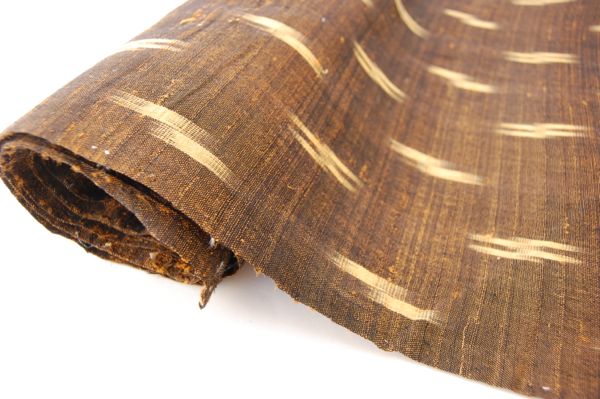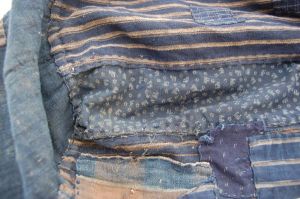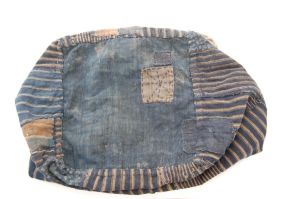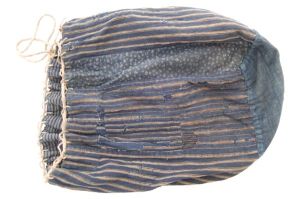
backside-silk floats across two flowers
I wanted t0 do a little post on some of the fabrics I brought back with me from Japan. The first one is a bit of a curiosity to me which is why I bought it at one of the temple sales I wandered through. I’m sure this technique has a name and a history but since I had never seen it ( or noticed it) before, I was quite unaware of it. At first I was drawn to it because of the indigo, next by the hemp, and also by the subtle pattern woven into it. Then I noticed that it was also embroidered with silk here and there. Not only that, but what I saw as embroidery seems to actually have been added into the design as it was being woven. There are large floats across the back too. What is this called? Is it common? I like so many things about this fabric. I like the uncommon pairing of the course hemp and the lustrous silk. Perhaps John Marshall might know- or a weaver passing through…

asa (hemp) weaving indigo
The light flowers, stems, and leaves first appear as if they could be katazome, but no. The back side shows the motif as darker than the ground. A form of kasuri? Or just a kind of double weave floating the lighter weft over the darker warp threads. I just don’t know. Again, a question for a weaver to answer. And then with the silk. a soft handspun yarn lightly dyed -perhaps with madder. Three pieces of this I dug out of a pile of things under a table, appear to be an old obi.
Then there was this-

cotton or linen warp, silk weft kasuri
~this was found at the same flea market where I found the zakuri. the seller had several fine textiles. Makoto bought one especially nice boro kimono for his wife. This was in his scrap box (where I shop!) and I loved the color and the two way kasuri pattern. The warp is a fine black cotton and the weft a lovely orange slightly slubby fine silk. A great combo. He had several pieces and I bought only two and had regrets by the time I got home for not buying it all. To our surprise, the next day we saw him again at a different temple sale and I asked if he had brought it with him and he dug it out of a box and I bought the rest. So 5 pieces in all-a kimono that was taken apart for cleaning and never put back together. I love that about kimono. The making of them does not require cutting into the fabric except for length and in the end you can dismantle the piece and use it all over again. What plain and common sense!

kasuri detail
Walking back to the train one day I came upon a small street where a few vendors had thrown down some tarps with kimono and fabric piled onto them. I picked up a couple of things-

The one on the left (partially shown) is a shibori noren. Likely made or at least tied in China. The other one seemed more possibly Japanese. I liked what I saw in it.
 Two kasuri jackets or possibly summer weight yogi (for sleeping) – both in great condition. All hand sewn. Each use different cotton kasuri fabrics. A couple of small seam repairs and I may put one of them in the shop. It’s quite small. But the fabric is wonderful.
Two kasuri jackets or possibly summer weight yogi (for sleeping) – both in great condition. All hand sewn. Each use different cotton kasuri fabrics. A couple of small seam repairs and I may put one of them in the shop. It’s quite small. But the fabric is wonderful.
I’ve saved the best for last-

komebukuro-sack for offering rice at the temple for special religious ceremonies
~this particular one appears to be quite old and with many boro patches. It employs various homespun cotton fabrics and the rope appears to be handmade from hemp fibers. Also quite large-12 x 20″ at least. The inside is more interesting than the outside-you can better see the patchwork. I would guess this one to be from the Meiji era (1868-1912). I appropriately found it at a temple sale. A few more pics of it:

inside full view-1

more inside detail

edge detail and rope

bag bottom inside

outside view 2

another outside view
And today, while silk was steaming on poles, I dyed up the mandalas I exampled in the online workshop-

indigo mandala with itajime on cotton organza
that’s all I can manage right now-whoops, except for this:

itajime indigo on hemp- table mat and coasters
Took this for a test drive and liked it-fabric is some hemp I found along with the komebukuro and I’ve backed the coasters with a little hand stitched kasuri. They’re reversible. Moons of course. I keep wondering why we can’t have hemp in this country…it’s just such a practical enduring fabric.
whoops- almost forgot the silk-some kimono lining silk rescued and indigo dyed-

kimono lining silk indigo dyed
There is a shop update in the near future.

You are as crazy as I am… at least you don’t have a nagging husband with you saying… and WHAT are you going to USE THAT for??? LOVE everything… especially that first fabric… look forward to learning what you hear about it.
LikeLike
hmmm…
LikeLike
such wonderful things you found there , i can almost hear the discussion with Jude about the 1e piece.
I love the little boro sack!
LikeLike
it’s like each one is trying to talk to me! to tell me it’s past.
LikeLike
Yes!
LikeLike
Such lovely pictures of possibly storied pieces. Thanks for sharing.
LikeLike
it’s the stories each one tells. and what i can learn from it
LikeLike
I love that first fabric – and I see things in it – I will send you a jpeg of what I see. xo
LikeLike
got it- thanks
LikeLike
Such lovely textiles! I especially love the rice bag. And your mandala. I can’t see it really clearly but I think your first fabric is a damask weave with supplementary weft brocade. Some of the long floats were left on the back where the distance between motifs was shorter.
LikeLike
good guess. someone else suggested lampas weaving with brocade too.
funny i didn’t think of damask… most all damask i have seen has been done with silk, linen, and rayon. the hemp was throwing me. i love though how the silk brocade is done in a sort of fleeting way. not covering all the flower motifs or even completely over all of the ones it does cover. so japanese- like cherry blossoms after rain.
LikeLike
The first fabric is a lancé, which is an effect created while weaving with an extra weft (in this case), so called because in French to throw is said ‘lancer’. The extra weft is ‘thrown’ from one repeat of the pattern to the other on the back of the weave, then the floating weft are either kept as they are or cut.
And probably it is a damask as Louisa said and how I can gather from your description.
LikeLike
so is lançe another term for brocade?
LikeLike
It could indeed be a lampas structure. I’d need a magnifying glass to tell for sure. I was just going by the dark vs light and reversed on the opposite face which made me think of damask. Draw-loom woven for sure though!
LikeLike
i did look at it with a magnifying glass but not educated enough to tell the difference. perhaps I can take a photo with my better camera up close…
LikeLike
These comments about how that first one was woven are fascinating!!! I have to know more about weaving and different types, have to start looking for good books…I have to know!!!!
For me, that oni panel, or half of the oni (oni is demon or devil) next to the noren bits is really intriguing and freaking incredible work. I imagine is was half of the back panel of a kimono or hapi or something likewise. Make me feel maybe I should start stitchin……
LikeLike
yes, the oni piece is only half. unfortunately, i asked for and thought i purchased both pieces. but when i got home he had only put one in the bag. oh well. if you really start looking at some of the fabrics in the markets over there in detail you can really find some astonishing things.
LikeLike